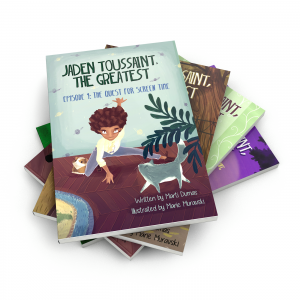 Long before I saw Marti Dumas face to face, I met her through her characters – Jaden Toussaint, the big-brained kindergartner with the fly Afro, Jupiter Storm, the tween leader who loves science and becomes the caretaker of a special creature. Something about her story sensibility struck me. Black young heroes and magic. Her stories were right on time.
Long before I saw Marti Dumas face to face, I met her through her characters – Jaden Toussaint, the big-brained kindergartner with the fly Afro, Jupiter Storm, the tween leader who loves science and becomes the caretaker of a special creature. Something about her story sensibility struck me. Black young heroes and magic. Her stories were right on time.
Though Marti didn’t have the engine of a big publisher behind her, I kept seeing her books on FaceBook and Twitter, on lists of books to read. She was building an audience through her creativity, passion and hard work. Kirkus said this about her middle-grade Jupiter Storm: “In more ways than one, a tale about young creatures testing their wings; a moving, entertaining winner.”
Marti is as humble as she is talented as you’ll read below. Thank you, Marti, for sharing your gift and keys to success.
Making Your Own Market: Nine Steps to Marketing Success
By Marti Dumas
When The Brown Bookshelf asked me to write an article about children’s book marketing, I was flattered, but  flummoxed. After all, I am not a big writer. I have not worked with a big publisher or had an agent. To date, none of my books have been on the New York Times bestseller list, I have not been blessed with a phone call from Oprah, and only about 200,000 copies of my books have made it into the hands of readers. 200k is more than zero, but believe me—there are tons of children’s book authors who have sold many, many more books. Nothing about me is all that special. Then it hit me. Maybe not being that special is exactly why I should write an article about children’s book marketing. So often what we hear are the stories of extreme success. I aspire to that as well, but lightning in a bottle is hard to replicate. I won’t say that what I have done is easy, but it is replicable, so maybe that makes it a good place to start.
flummoxed. After all, I am not a big writer. I have not worked with a big publisher or had an agent. To date, none of my books have been on the New York Times bestseller list, I have not been blessed with a phone call from Oprah, and only about 200,000 copies of my books have made it into the hands of readers. 200k is more than zero, but believe me—there are tons of children’s book authors who have sold many, many more books. Nothing about me is all that special. Then it hit me. Maybe not being that special is exactly why I should write an article about children’s book marketing. So often what we hear are the stories of extreme success. I aspire to that as well, but lightning in a bottle is hard to replicate. I won’t say that what I have done is easy, but it is replicable, so maybe that makes it a good place to start.
Step 1: Know Why You Want to Publish
This may sound basic and basically not related to marketing, but this part is important. I don’t think you can skip it, especially if you don’t have a huge marketing budget behind you. To be willing to put the work in, you must either believe in the importance of your mission or get a new one.
I spent thirteen years as an elementary school teacher and six years as a parent looking for books that reflected my kids. I found a few, but not nearly enough. When I first started, most of the books about black and brown kids that were easy to find were about American chattel slavery or the Civil Rights movement. Those books are important. We must have them. But as I helped child after child look for the books that would help them discover their own love of reading, it was disheartening that more often than not, if a child wanted a book about magic or space travel or ordinary school day problems, I had to hand them a book about a white child. There’s nothing wrong with that, of course. We should all read about people who are at least a little different from ourselves. But that can’t be all you have.
Stories are powerful. They get in our heads and shape what we think the world can be. I was helping children find their love of reading, but I was also quietly teaching them that white children can be anything. That white children are the heroes of the stories and everyone else is there to be their sidekicks. That’s not a lesson I want to teach—not to black children, not to white children, not to anyone. Helping to correct that imbalance is the biggest part of my mission. It drives me and makes me know that it is important that I publish, not just write. That no matter how shy I might be about my own words or how inconsequential I suspect they may be, until the imbalance is corrected, they are needed and I can’t quit.
Your mission may be different from mine. That is perfectly fine. Passion and purpose are the only things our missions need to have in common. The rest is up to you.
Step 2: Know Who You Are Writing For
Don’t say “everybody.” I know. Great stories can and will appeal to many different people. It might feel strange to limit yourself to a very specific person, but when you write a story for “everybody” you kind of shoot yourself in the foot for both writing and marketing. Don’t worry that writing for a specific child means other children won’t be able to relate. If it is a good story, I promise you they will. Specificity will help make it good.
My first series, Jaden Toussaint, the Greatest, was written especially for my son, a super-smart, five-year-old black boy from New Orleans. I wrote that series to reflect his tastes, his fears, his hopes, his desires. The Jaden Toussaint books are a sketch of my son’s real life as a kindergartener that are full of so many odd details and inside jokes that no one else should relate to them. The opposite is true, and I think I know why. As special as my son is, he is not alone. There are tons of other highly intelligent, sensitive, stubborn, loving black boys out there. By writing for my son, I wrote for those children as well, and now I’ve lost track of how many dozens of parents have written to me asking me how I managed to write a book about their child. And it’s not only boys or black children or children from New Orleans who are enjoying those stories. Making them very specific makes them feel real, and feeling real makes them universal, even if some of the children have to use context clues to figure out what a beignet is. It’s fine. I did the same thing when I read The Lion, the Witch, and the Wardrobe and Edward was going crazy over Turkish delight.
Step 3: Work on Your Craft
 This step is ongoing. None of us is ever done. So read craft books, join SCBWI, join critique circles, go to conferences, and read as many books in your category as you can manage. I do all of those things, but I assume everyone is doing them, too. What I don’t hear people doing as often that has really helped me with marketing is this: Read your stories to young readers, preferably before anyone else. That includes your editor.
This step is ongoing. None of us is ever done. So read craft books, join SCBWI, join critique circles, go to conferences, and read as many books in your category as you can manage. I do all of those things, but I assume everyone is doing them, too. What I don’t hear people doing as often that has really helped me with marketing is this: Read your stories to young readers, preferably before anyone else. That includes your editor.
Remember that very specific young person you were writing for in Step 2? Find that young person. Read your writing to them and watch their face. No matter what, you will learn something from their reactions. You might even learn that people you thought were your main readers are not your main readers at all. That may feel frustrating at first, but it’s a good thing where marketing is concerned.
Step 4: Talk to the Right People
If you know why you’re writing and who you’re writing for, it’s easy to figure out who to talk to. For Jaden Toussaint, the Greatest, we needed to talk to people who help get books to a very specific group of children—black boys between 5 and 7-years-old. Are those the only people we thought would read the Jaden Toussaint books? Absolutely not. It was a starting point. Working with a small publisher meant that I could keep my mission laser-focused, but it also meant that we didn’t have the buying power to pay for booths at national conferences or to print thousands of advance reading copies. Fortunately, those are not the only ways to talk to people. Our limited budget just forced us to be more strategic.
We placed small ads in places like Facebook and Instagram, but our goal was not to sell books, it was to talk to people. We aimed the ads at black teachers, parents, and librarians. We told them who we were writing for and why. We told them how children reacted to the stories and where they could buy them if they wanted, but mostly we listened and had real conversations with the people who engaged with us.
The numbers were tiny at first, but slowly the people who vibed with our mission began to share it. We started hearing from teachers, librarians, bloggers, and booksellers, and we listened to them, too. Some people believed in our work so much that they joined one of our mailing lists, and we use those to keep the conversations going long after advertising ends.
Step 5: Be of Service
When you’re talking to the right people, the biggest thing you want to know is how you can help them. Yes, they can help you by buying your books, but it’s much more important that you figure out how you can help them. For me that has meant making teacher resources, recording read alouds, and doing tons of school visits both in person and online. I don’t do those things because I saw them on a list of marketing tips. I do them because the people I talked to said they needed them.
Step 6: Avoid Gimmicks…Unless They Bring You Joy
 Did I run a campaign promising mermaid stickers to the first hundred families that responded? Yes. Did it sell any books? I have no idea. Would I do it again? ABSOLUTELY. It was fun. I had fun making the stickers. I had fun addressing the envelopes and writing little responses. I had fun finding stamps that would match the rest of the mailing. It doesn’t matter how many books those stickers sold. However, if I were making mermaid stickers to sell books, it would have been a waste of time and resources. There is no way for me to connect stickers to book sales, so if that is my goal and I have a limited amount of money to spend, I would be better off investing in something that is directly connected to sales. But sales aren’t everything. The occasional investment in fun is worthwhile, if you know that’s what you’re doing and take the time to enjoy it.
Did I run a campaign promising mermaid stickers to the first hundred families that responded? Yes. Did it sell any books? I have no idea. Would I do it again? ABSOLUTELY. It was fun. I had fun making the stickers. I had fun addressing the envelopes and writing little responses. I had fun finding stamps that would match the rest of the mailing. It doesn’t matter how many books those stickers sold. However, if I were making mermaid stickers to sell books, it would have been a waste of time and resources. There is no way for me to connect stickers to book sales, so if that is my goal and I have a limited amount of money to spend, I would be better off investing in something that is directly connected to sales. But sales aren’t everything. The occasional investment in fun is worthwhile, if you know that’s what you’re doing and take the time to enjoy it.
Step 7: Measure
People say what gets measured gets managed. I really believe that is true. Unless what you’re doing is an investment in fun, you must measure it to see if it was worth the investment. The question is, what should you measure? Book sales, certainly, but that shouldn’t be the only thing, particularly not in the beginning. Other things you should keep track of are:
- The people on your mailing list, including who joins, who stays, who leaves, and who responds to messages
- Conversations about your book in person and online
- Fan mail and thank you letters
- School visit requests
- Supplemental materials requests or downloads
- Requests for donations
- Messages from parents, teachers, librarians, and other adults who care for young people
- Reviews
- People posting about your book online
Step 8: Be Patient
It may take time for you to find the right people to talk to and even longer for those people to share your books with the people they love. That’s okay. Children’s book marketing is a long game. Remember your mission, work your plan, and give it time to unfold. Most people quit, so not quitting automatically gives you a leg up and buys you enough time to see growth in at least one area.
Step 9: Share Your Journey
Where direct sales are concerned, social media is a gimmick. Can social media sell books? Yes. Sort of. For me, the connection between social media and sales is so indirect that I’d tear my hair out trying to measure it. In my experience, social media is meant for sharing the joy (and the occasional stumbling block) of the journey. People love to be a part of joy. It makes them feel happy. They feel connected to you and you have an opportunity to connect with them. That might result in sales down the line, but this is a place where just looking at sales misses the point. As storytellers, there is everything right with sharing our journeys. Those stories keep us going and inspire people to either join us or start their own journeys along the way, whether or not they ever buy a book.
So there you have it, the nine things I have done and will continue to do to market my children’s books. No, lightning, but hopefully there was a spark or two to that will help to light your path.

Great article, Marti. I especially liked steps 4 and 5, talking to the right people and being of service to them. The idea of marketing oneself has such a narcissistic ring to it, that many writers struggle to take part. Those steps, in particular, are a great way to focus on others while still helping ourselves along. Thanks for sharing!
I 💙 the Jaden Toussaint books, the mermaid, the dragon, & Marti Dumas!
I can’t wait to read each new offering, & am sad when I finish one.
Keep writing, & keep having fun!
I really appreciate this article. Thank you!